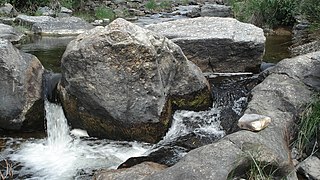See also
- Geography of Europe
- List of European rivers with alternative names
- Latin names of European rivers
- European river zonation
- Relevant pages from Portuguese Wikipedia:
This is a list of the rivers of Portugal , including all the main stems and their tributaries.
Note: This list was taken from Lista de rios de Portugal in the Portuguese Wikipedia, with Rio x converted to xRiver.

The Porto Metropolitan Area is a metropolitan area in northern Portugal centered on the City of Porto, Portugal's second largest city. The metropolitan area, covering 17 municipalities, is the second largest urban area in the country and one of the largest in the European Union, with a population in 2021 of 1,737,395 in an area of 2,040.31 km².

Peneda-Gerês National Park, also known simply as Gerês, is a national park in Norte Region, Portugal. Created in May 1971, it is the oldest protected area and the only national park in Portugal. It covers an area of 695.9 km2 (268.7 sq mi), occupying the Districts of Viana do Castelo, Braga, and Vila Real and bordering the Spanish Baixa Limia – Serra do Xurés natural park to the north, with which forms the UNESCO biosphere reserve of Gerês-Xurés.

The Ribatejo is the most central of the traditional provinces of Portugal, with no coastline or border with Spain. The region is crossed by the Tagus river. The region contains some of the nation's richest agricultural land, and it produces most of the animals used in the Portuguese style of bullfighting.

Águeda is a city and a municipality in Portugal. According to the Portuguese 2011 census, the municipality of Águeda had 47,729 inhabitants, in an area of 335.27 km2 (129.45 sq mi). The city proper had a population of 14,504, while the remainder is distributed in 11 parishes, within the Baixo Vouga Subregion.

The North Region or Northern Portugal is the most populous region in Portugal, ahead of Lisbon, and the third most extensive by area. The region has 3,576,205 inhabitants according to the 2017 census, and its area is 21,278 kilometres (13,222 mi) with a density of 173 inhabitants per square kilometre. It is one of five regions of Mainland Portugal. Its main population center is the urban area of Porto, with about one million inhabitants; it includes a larger political metropolitan region with 1.8 million, and an urban-metropolitan agglomeration with 2.99 million inhabitants, including Porto and neighboring cities, such as Braga, Guimarães and Póvoa de Varzim. The Commission of Regional Coordination of the North (CCDR-N) is the agency that coordinates environmental policies, land-use planning, cities and the overall development of this region, supporting local governments and associations.

Beira Litoral is a historical province (província) of Portugal, formally instituted in an administrative reform of 1936. It was abolished with the 1976 Constitution of Portugal.

Linha do Vouga(the Vouga line) is the last surviving metre gauge railway line in Portugal still operated by Comboios de Portugal. The other remaining metre gauge lines all closed in 2009.

Vila Real is the capital and largest city of the Vila Real District, in the North region, Portugal. It is also the seat of the Douro intermunicipal community and of the Trás-os-Montes e Alto Douro historical province. The Vila Real municipality covers an area of 378.80 square kilometres (146.26 sq mi) and is home to an estimated population of 49,574 (2021), of which about 30,000 live in the urban area (2021).

The Azibo River is a Portuguese river in the Douro River basin. It has its source in the Nogueira mountains, near the place of Rebordainhos, Bragança Municipality, in the northeast of Portugal. Along its 50 kilometres (31 mi) of length, it crosses the Macedo de Cavaleiros Municipality, where in 1982 an earthfill dam was built near Santa Combinha place . The Azibo river has its mouth near the place of Lagoa, on the right bank of Sabor River, which is a tributary of Douro River.

The Corgo line(Portuguese: Linha do Corgo) was a 1,000 mmmetre gauge railway line in northern Portugal. It closed in 2009. It ran north from Régua to Vila Real and Chaves. The line was latterly operated by Comboios de Portugal.

Portugal formerly had several hundred kilometres of narrow-gauge railways, but by 2010 only two lines were still in operation – the Vouga line and the Metro de Mirandela. The lines were operated by Comboios de Portugal and maintained by REFER.

The intermunicipal community is a type of administrative division in Portugal. Since the 2013 local government reform, there are 21 intermunicipal communities. They replaced the urban communities, the intermunicipal communities for general purposes and some metropolitan areas that were created in 2003, and abolished in 2008. The territories of the intermunicipal communities are the basis of the NUTS III statistical regions.
Infraestruturas de Portugal, S.A. (IP) is a state-owned company which resulted from the merger of Rede Ferroviária Nacional (REFER) and Estradas de Portugal (EP). It manages the Portuguese rail and road infrastructure.